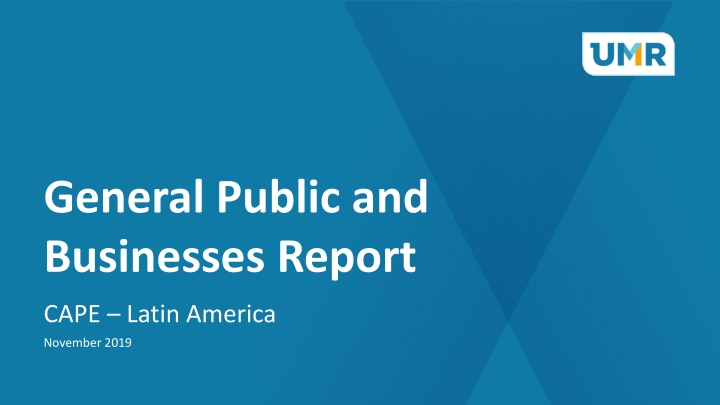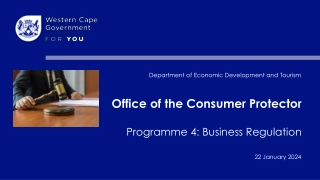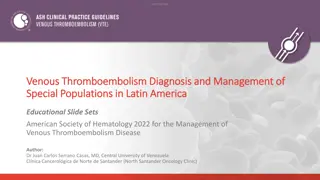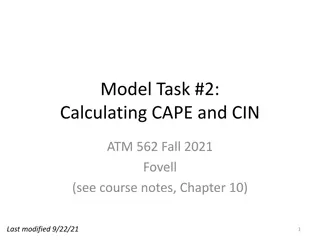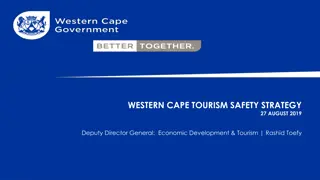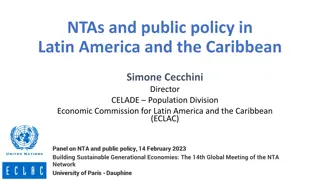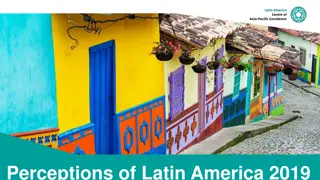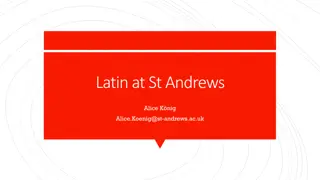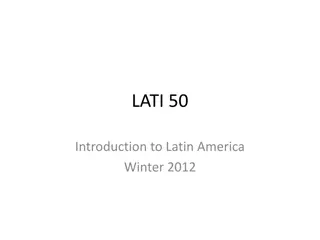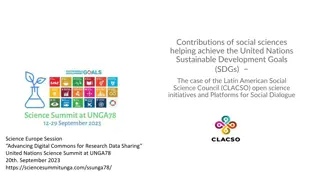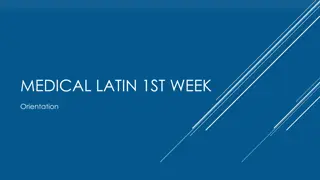CAPE Latin America General Public and Businesses Report November 2019
The CAPE Latin America report delves into public and business perceptions of the region through surveys conducted in November 2019. It explores topics such as awareness, knowledge sources, visitation experiences, and business success. The research objectives outline the need to understand public perceptions specifically in Latin America, leading to annual surveys to analyze opportunities and challenges in engaging with the region. The methodology section details the online surveys conducted with a total sample size of 253, providing insights into the public and business perspectives.
Download Presentation

Please find below an Image/Link to download the presentation.
The content on the website is provided AS IS for your information and personal use only. It may not be sold, licensed, or shared on other websites without obtaining consent from the author.If you encounter any issues during the download, it is possible that the publisher has removed the file from their server.
You are allowed to download the files provided on this website for personal or commercial use, subject to the condition that they are used lawfully. All files are the property of their respective owners.
The content on the website is provided AS IS for your information and personal use only. It may not be sold, licensed, or shared on other websites without obtaining consent from the author.
E N D
Presentation Transcript
General Public and Businesses Report CAPE Latin America November 2019 1 CAPE Latin America General Public and Businesses Report November 2019
Contents Research objectives Methodology General public Importance and awareness of Latin America Knowledge and information sources of Latin America Visitation and personal experience with Latin America Education New Zealand s business relationship with Latin America Business Importance and awareness of Latin America Knowledge and information sources of Latin America Visitation and personal experience with Latin America Education Business success in Latin America New Zealand s business relationship with Latin America Conclusion 2 CAPE Latin America General Public and Businesses Report November 2019
Research objectives In 2018, the Centres of Asia Pacific Excellence commissioned UMR Research NZ to carry out a poll around the public perceptions of the Asia Pacific region. Although the initial findings proved useful, the Latin America CAPE identified the need to further understand public perceptions pertaining specifically to the Latin America region. Therefore the Latin American CAPE have commissioned UMR Research to carry out a standalone poll of n=1,000 people from the general public, followed by a poll to target n=150 businesses involved in exporting, importing or investing in countries outside of New Zealand. The Latin America specific poll will be the first of further surveys that the CAPE plan to carry out on at least an annual basis going forward. Consequently, allowing in-depth year on year analysis around the perceived opportunities and challenges of engaging with, and doing business in Latin America. Notes on reporting The report is split into two sections, the first outlines the general public results (n=1,000). The second section outlines the business results (n=253). 3 CAPE Latin America General Public and Businesses Report November 2019
Methodology Quantitative research (general public online survey n=1,000) Representative sample of the general public aged 18 years and over. The general public sample identified 103 respondents who are decision makers of businesses involved in exporting, importing or investing in countries outside of New Zealand Fieldwork was conducted from 30thof October to the 11thof November 2019 The margin of error for a sample size of n=1,000 is plus or minus 3.1% Additional over-sample of decision makers involved in businesses that export, import or invest in countries outside of New Zealand (n=150) Fieldwork 11thto the 15thof November 2019 This sub-group of n=150 was added to the 103 identified in the general public sample to give a total sample size of 253. The margin of error is plus or minus 6.1% Note on rounding. All percentages are shown rounded to zero decimal places. Some sub-totals are not always equal to the sum of the individual percentages, but the differences are seldom more than 1%. For example: 47.7 + 47.7 = 95.4 would appear as 48 + 48 = 95. 4 CAPE Latin America General Public and Businesses Report November 2019
Executive summary General public Importance and awareness of Latin America Even though around three-fifths (57%) think Latin America is important to New Zealand, there is limited awareness of differences between Latin American nations. Over one-third (37%) of respondents declared they have some awareness of the differences between Latin American nations, while 61% do not. Travel and leisure is seen at the strongest link between New Zealand and Latin America followed by Business and trade . Respondents were asked to think positively about Latin America and then nominate a positive word: Culture , Happy/ Fun/ Friendly and Vibrant/ Energy were the positive top of mind terms. Respondents were also asked to think negatively about Latin America and then nominate a negative word: Drugs and Crime were the negative top of mind terms, followed by Poverty/ Inequality . There is a relatively even split between those who rate their intercultural skills highly (50%) and those who rate their skills not highly (48%). Knowledge and information sources of Latin America Only one-quarter keep up to date with developments in Latin American politics, economics, business or culture. Over half (54%) source their information about Latin America from traditional media followed by 38% from social media. Friends and popular culture featured at lower levels. Over one-third selected Lack of news on the region as a barrier to increasing their awareness of Latin American nations. Around one-quarter selected Lack of Spanish or Portuguese and Lack of prior knowledge as barriers. Close to three out of 10 chose No barriers . Visitation and personal experience with Latin America Less than one in ten respondents have visited Latin America in the past five years and a little under one-third are likely to travel to Latin America in the next five years. Two-fifths are aware that there are direct flights from Auckland to Santiago (Chile) and Buenos Aires (Argentina). Three in five respondents feel it is important to have a personal experience of visiting Latin America or knowing Latin Americans in encouraging an interest in this region. 5 CAPE Latin America General Public and Businesses Report November 2019
Executive summary General public Education Overall the general public are generally receptive to education around Latin American nations and language. The vast majority strongly support New Zealand children learning more than one language. Although respondents are divided on how important it is for New Zealanders to learn Spanish or Portuguese (49% important and 47% not important). Close to two-fifths are willing to learn Spanish or Portuguese, while one-third consider that these languages are not relevant to them and one-fifth are just not interested in learning these languages. Just under half (45%) think it is important for New Zealand schools to teach more Latin American content. Around one-third of general public respondents think it is likely that they will develop their Latin American knowledge and skills in the next five years. In terms of what Latin American-related knowledge and skills New Zealanders need to learn, general public respondents selected Intercultural skills at 54%. Language skills and Business skills featured at slightly lower levels (45% and 33% respectively). New Zealand s business relationship with Latin America Just under one-quarter (23%) believe Argentina to be the most important Latin American country to New Zealand followed by one-fifth selecting Brazil. One-third are aware that Chile, Mexico and Peru are active members of APEC. 6 CAPE Latin America General Public and Businesses Report November 2019
Executive summary Businesses Current business relationship with Latin America Just over one-fifth of business respondents currently export to, invest in or import from Latin America while 42% are open to the idea. Importance and awareness of Latin America The majority (84%) of business respondents think Latin America is important to New Zealand. There is reasonably high awareness of the differences between Latin American nations (72% aware). Similar to the general public findings, Travel and leisure is seen at the strongest link between New Zealand and Latin America followed by Business and trade . When asked to nominate one positive and negative word that they relate to Latin America. Great/ Amazing/ Good and Happy/ Fun/ Friendly were the top two positive terms with Latin America amongst business respondents. Drugs and Poverty/ Inequality were the top of mind negative terms. Three-quarters of business respondents rate their intercultural skills highly (76%) and one-quarter rate their skills not highly (24%). Knowledge and information sources of Latin America Two-thirds of business respondents keep up to date with developments in Latin American politics, economics, business or culture. Traditional media and social media are the two top sources of information about Latin America that were selected, followed by friends and government reports which featured at lower levels. Thirty percent think that their, Lack of Spanish or Portuguese is a barrier to increasing their awareness of Latin American nations followed by, Lack of news on the region . Just over one-quarter feel there are no barriers to increasing their awareness. When asked about barriers to doing more business with Latin America, Language barriers , Cost of travel/ doing business and Lack of knowledge of opportunities are the top three barriers selected by business respondents. Trade barriers , Lack of peers working in the region and Political or bureaucratic challenges were selected by around one-quarter of respondents (24%, 24% and 23% respectively). Visitation and personal experience with Latin America One-third of business respondents had visited Latin America in the past five years and just over two-thirds are likely to travel to Latin America in the next five years. Awareness of direct flights from Auckland to Santiago (Chile) and Buenos Aires (Argentina) was higher among the business respondents than the general public (62% business, 40% general public). Three-quarters of business respondents feel it is important to have a personal experience of visiting Latin America or knowing Latin Americans in encouraging an interest in this region. 7 CAPE Latin America General Public and Businesses Report November 2019
Executive summary Businesses Education Overall the business respondents are very receptive to education around Latin American nations and language. The vast majority strongly support New Zealand children learning more than one language. Seven out of 10 business respondents feel it is important for New Zealanders to learn Spanish or Portuguese. A little over two-fifths indicated they are willing to learn Spanish or Portuguese. Twelve percent stated they are fluent or competent in Spanish or Portuguese. Close to one-fifth indicated that these languages are not relevant to them and 8% are just not interested in learning these languages. Two-thirds (66%) think it is important for New Zealand schools to teach more Latin American content. Three-fifths of business respondents indicated it is likely that they will develop their Latin America knowledge and skills in the next five years. In terms of what Latin American-related knowledge and skills New Zealanders need to learn, business respondents selected Language skills at 53%. Intercultural skills and Business skills featured at slightly lower levels (48% and 45% respectively). Business success in Latin America Four-fifths of business respondents think that the enjoyment of the culture and people is important when choosing markets to focus on. The vast majority of business respondents think that knowledge of local languages and local cultures is important for business success in Latin America (89% each). New Zealand s business relationship with Latin America Argentina and Brazil were tied at 24% each as the most important Latin American country to New Zealand. Close to three-fifths (58%) are aware that Chile, Mexico and Peru are active members of APEC. Around half are aware that CPTPP has improved current access to Chile and has created new opportunities to export goods or services to Mexico and Peru. There is limited awareness of which countries are included in both the Pacific Alliance trade bloc and the Mercosur trade bloc. 8 CAPE Latin America General Public and Businesses Report November 2019
Sample detail General public (n=1000) % 49 51 22 25 26 27 33 11 13 32 11 67 13 6 15 8 Businesses (n=253) % 64 36 24 45 19 12 44 12 13 24 8 57 8 8 22 9 25 Male Female 18-29 30-44 45-59 60+ Auckland Wellington Canterbury Other North Island Other South Island New Zealand European M ori Pacific Island Asian Multiple response Others 9 CAPE Latin America General Public and Businesses Report November 2019
General public Importance and awareness of Latin America 10 CAPE Latin America General Public and Businesses Report November 2019
More think Latin America is important to New Zealand than not important Over half (57%) think it is important and just over one-third (36%) think it is not As you may be aware, Latin America refers to the countries of the Americas south of the US border that were former colonies of Spain or Portugal. The term covers Mexico, almost all of central and South America, and the Spanish speaking islands of the Caribbean. In general, how important do you think Latin America is to New Zealand? (Q1) Differences among sub-groups Close to two-thirds (63%) of males think Latin America is important to New Zealand compared to 52% of females. Similarly, close to two-thirds (63%) of those working full- time think Latin America is important to New Zealand compared to 50% of those not in paid employment. Among the small sub-group of those who have visited Latin America in the past five years (n=72), 82% think Latin America is important to New Zealand compared to 55% of those who have not visited. Likewise, those who are likely to visit Latin America in the next five years, close to three-quarters (74%) think Latin America is important to New Zealand compared to 49% who are not likely to visit. Total important 57 Total not important 36 Very important 12 Somewhat important 45 Not that important 30 Not important at all 5 Unsure 7 0% 20% 40% 60% 80% 100% Base: General public respondents (n=1,000) 11 CAPE Latin America General Public and Businesses Report November 2019
Just over one-third (37%) have some awareness of the differences between individual Latin American nations while 61% do not Which of the following best describes your awareness of the differences between individual Latin American nations? (Q2) Differences among sub-groups 43% of males declared to have some awareness of the differences between individual Latin American nations compared to 31% of females. Among the small sub-group of those who have visited Latin America in the past five years (n=72), 84% declared to have some awareness of the differences between individual Latin American nations compared to 33% of those who have not visited. Just over half (54%) of those who are likely to visit Latin America in the next five years declared to have some awareness compared to around one-quarter (26%) who are not likely to visit. Total aware 37 Total not aware 61 Very aware 6 Quite aware 31 Not that aware 48 Not aware at all 13 Unsure 2 0% 20% 40% 60% 80% 100% Base: General public respondents (n=1,000) 12 CAPE Latin America General Public and Businesses Report November 2019
Travel and leisure is seen as the strongest link between New Zealand and Latin America followed by Business and trade What do you feel is the strongest link between New Zealand and Latin America today? (Q8) Those who think Latin America is important to New Zealand are more likely to feel that Business and trade is the strongest link between New Zealand and Latin America at 36% followed by Travel and leisure at 28%. Those who think Latin America is NOT important to New Zealand are more likely to feel that Travel and leisure is the strongest link between New Zealand and Latin America at 42% followed by Business and trade at 15%. Travel and leisure 33 Business and trade 27 Sport 10 Political and diplomatic links 7 Educational links 4 Other cultural links 4 Unsure 15 0% 20% 40% 60% Base: General public respondents (n=1,000) 13 CAPE Latin America General Public and Businesses Report November 2019
Culture, Happy/ Fun/ Friendly and Vibrant/ Energy are the positive top of mind terms used to describe Latin America When you think POSITIVELY about Latin America, what SINGLE POSITIVE WORD comes to mind? (Q3) Base: General public respondents (n=1,000) 14 CAPE Latin America General Public and Businesses Report November 2019
Drugs and Crime are the negative top of mind terms used to describe Latin America, followed by Poverty/ Inequality When you think NEGATIVELY about Latin America, what SINGLE NEGATIVE WORD comes to mind? (Q4) Base: General public respondents (n=1,000) 15 CAPE Latin America General Public and Businesses Report November 2019
A relatively even split between those who rate their intercultural skills highly (50%) and those who rate their skills not highly (48%) How highly do you rate your own intercultural skills (for example foreign language skills, cultural awareness and sensitivity)? (Q14) Those who rated their own intercultural skills more highly: Aucklanders (60%) vs. rest of NZ (45%) Those aged 18-29 (60%) or 30-44 (65%) vs. 60+ (35%) Those who have visited before (83%) vs. those who have not (48%) Those likely to visit in the next five years (74%) vs. those who are not (39%) Those with a university qualification (66%) vs. those with no formal qualification or a secondary school qualification (36%) Total highly 50 Total not highly 48 Very highly 13 Somewhat highly 38 Not that highly 34 Not highly at all 14 Unsure 2 0% 20% 40% 60% 80% 100% Base: General public respondents (n=1,000) 16 CAPE Latin America General Public and Businesses Report November 2019
General public Knowledge and information sources of Latin America 17 CAPE Latin America General Public and Businesses Report November 2019
Much less likely to be up to date with developments in Latin American politics, economics, business or culture 25% up to date vs. 74% not up to date How up to date are you with developments in Latin American politics, economics, business or culture? (Q5) Differences among sub-groups Males are more likely than females to declare that they are very or quite up to date with developments in Latin American politics, economics, business or culture (33% vs. 17%). Unsurprisingly, close to three-quarters (73%) of those who have visited Latin America in the past five years, are more likely to be up to date than those who have not visited (21%). Among those who are likely to visit Latin America in the next five years 41% declared that they are up to date versus 15% of those who are not likely to visit. Total Very + Quite up to date 25 Total not up to date 74 Very up to date 3 Very up to date with some 5 Quite up to date 17 Not very up to date 40 Not up to date at all 34 Unsure 1 0% 20% 40% 60% 80% 100% Base: General public respondents (n=1,000) 18 CAPE Latin America General Public and Businesses Report November 2019
Over half (54%) source their information about Latin America from traditional media followed by 38% from social media In general, what are your main sources of information about Latin America? (Q6) Differences among sub-groups Unsurprisingly, as age increased, so too did the use of traditional media: - 36% of those aged 18-29 - 46% of those aged 30-44 - 58% of those aged 45-59 - 72% of those aged 60 plus And, as age increased, the use of social media decreased: - 54% of those aged 18-29 - 47% of those aged 30-44 - 31% of those aged 45-59 - 25% of those aged 60 plus Traditional media 54 Social media 38 Friends 19 Popular culture 16 Personal interactions with Latin Americans 11 Government reports 10 Prior travel to the region 8 The education system (formal study) 6 Community groups 5 Other 6 Unsure 8 0% 20% 40% 60% Base: General public respondents (n=1,000). Multiple response question. 19 CAPE Latin America General Public and Businesses Report November 2019
Lack of news is seen as the biggest barrier to increasing awareness of Latin American nations followed by Lack of Spanish or Portuguese and Lack of prior knowledge What are the barriers to increasing your awareness of Latin American nations? (Q7) Compared to those aged 60 and over, younger respondents (those aged 18-29), were more likely to select: - Lack of prior knowledge (42%) - Lack of Spanish or Portuguese (39%) - Lack of peers to share views with (28%) - Lack of resources to guide you (27%) And, compared to those unlikely to visit in the next five years, those likely to visit, were more likely to select: - Lack of Spanish or Portuguese (36%) - Lack of resources to guide you (28%) - Lack of peers to share views with (23%) No barriers 29 Lack of news on the region 36 Lack of Spanish or Portuguese 27 Lack of prior knowledge 26 Lack of resources to guide you 18 Lack of peers to share views with 16 Other 4 Unsure 5 0% 20% 40% 60% Base: General public respondents (n=1,000). Multiple response question. 20 CAPE Latin America General Public and Businesses Report November 2019
General public Visitation and personal experience with Latin America 21 CAPE Latin America General Public and Businesses Report November 2019
Less than one in ten have visited Latin America in the past five years Have you visited Latin America in the past five years? (Q9) Those more likely to have visited Latin America in the past five years: - Aucklanders (11%) vs. rest of NZ (5%) - Males (9%) vs. females (5%) - Those aged 30-44 (11%) vs. 60+ (3%) - Those working full-time (12%) vs. not working (2%) - Household income of $100k or more (11%) - Those who home is owned freehold (11%) Yes No 7% 93% Base: General public respondents (n=1,000) 22 CAPE Latin America General Public and Businesses Report November 2019
Just over two-thirds (68%) are NOT likely to travel to Latin America in the next five years compared to 30% who are likely How likely is it that you will travel to Latin America in the next five years? (Q10) Those who are more likely to travel to Latin America in the next five years are: Aucklanders (40%) vs. rest of NZ (25%) Males (35%) vs. females (25%) Those aged 18-29 (48%) vs. 60+ (15%) Those working full-time (42%) vs. not working (15%) Those who have visited (86%) vs. those who haven t (25%) Household income of $100k or more (38%) Those with dependents (37%) vs. those without (26%) Those with a university qualification (40%) vs. those with no formal qualification or a secondary school qualification (19%) Total likely 30 Total not likely 68 Very likely 8 Somewhat likely 22 Not that likely 29 Not likely at all 38 Unsure 3 0% 20% 40% 60% 80% 100% Base: General public respondents (n=1,000) 23 CAPE Latin America General Public and Businesses Report November 2019
Four out of 10 are aware that there are direct flights to Chile and Argentina Are you aware that there are direct flights from Auckland to Santiago (Chile) and Buenos Aires (Argentina)? (Q20) Those more aware are: Aucklanders (47%) vs. rest of NZ (37%) Males (45%) vs. females (36%) Those aged 60+ (51%) Those who have visited before (78%) vs. those who have not (37%) Those likely to visit in the next five year (55%) vs. those who are not (31%) Those who own their own home (47%) Those with a university qualification (47%) vs. those with no formal qualification or a secondary school qualification (32%) Yes No Unsure 40% 57% 3% Base: General public respondents (n=1,000) 24 CAPE Latin America General Public and Businesses Report November 2019
Over half (58%) believe it is important to personally visit Latin America or know Latin Americans to encourage an interest in the region How important is personal experience of visiting Latin America or knowing Latin Americans in encouraging an interest in this region? (Q16) Those more likely to believe it its important are: Those who have visited before (88%) vs. those who have not (56%) Those likely to visit in the next five years (84%) vs. those who are not (46%) Those with a university qualification (70%) vs. those with no formal qualification or a secondary school qualification (44%) Total important 58 Total not important 38 Very important 16 Somewhat important 42 Not that important 24 Not important at all 14 Unsure 3 0% 20% 40% 60% 80% 100% Base: General public respondents (n=1,000) 25 CAPE Latin America General Public and Businesses Report November 2019
General public Education 26 CAPE Latin America General Public and Businesses Report November 2019
Support for New Zealand children learning more than one language is strong with over half strongly supporting this idea and just over one-third somewhat supporting How strongly do you support New Zealand children learning more than one language? (Q11) Those more likely to strongly support are: Those likely to visit in the next five years (72%) vs. those who are not (53%) Those with a university qualification (65%) No difference between those with dependents and those without dependents. Total support 94 Total oppose 4 Strongly support 58 Somewhat support 36 Somewhat oppose 3 Strongly oppose 1 Unsure 2 0% 20% 40% 60% 80% 100% Base: General public respondents (n=1,000) 27 CAPE Latin America General Public and Businesses Report November 2019
Around half (49%) believe it is important for New Zealanders to learn Spanish or Portuguese How important is it for New Zealanders to learn Spanish or Portuguese? (Q12) Those more likely to believe it is important are: Aucklanders (57%) vs. rest of NZ (45%) Those who have visited before (82%) vs. those who have not (46%) Those likely to visit in the next five years (71%) vs. those who are not (38%) Total important 49 Total not important 47 Very important 8 Somewhat important 41 Not that important 37 Not important at all 10 Unsure 4 0% 20% 40% 60% 80% 100% Base: General public respondents (n=1,000) 28 CAPE Latin America General Public and Businesses Report November 2019
Less than 5% are fluent or competent in Spanish or Portuguese and just over one-third 37% are willing to learn Which ONE of the following best describes your understanding of Spanish or Portuguese languages? (Q13) Those who are willing to learn are more likely to be: 18-29 (51%) or 30-44 (45%) vs. 60+ at 18% Likely to visit in the next 5 years (62%) vs. 28% of those not likely to visit Those with children in the household (45%) vs. those without (33%) Those with a university qualification (45%) vs. those with no formal qualification or a secondary school qualification (27%) I am fluent or competent in Spanish / Portuguese 4 I am willing to learn Spanish / Portuguese 37 Spanish or Portuguese would be difficult to learn 7 Spanish or Portuguese aren t very relevant to me 33 Just not interested 18 Unsure 2 0% 20% 40% 60% Base: General public respondents (n=1,000) 29 CAPE Latin America General Public and Businesses Report November 2019
Just under half (45%) think it is important for New Zealand schools to teach more Latin American content How important is it for New Zealand schools to teach more Latin American content? (Q17) Those more likely to think it is important are: Those who have visited before (69%) vs. those who have not (43%) Those likely to visit in the next five years (68%) vs. those who are not (35%) Those with a university qualification (53%) vs. those with no formal qualification or a secondary school qualification (36%) Total important 45 Total not important 50 Very important 7 Somewhat important 38 Not that important 36 Not important at all 14 Unsure 5 0% 20% 40% 60% 80% 100% Base: General public respondents (n=1,000) 30 CAPE Latin America General Public and Businesses Report November 2019
A little over one-third (36%) are likely to develop their Latin American knowledge and skills in the next five years How likely is it that you will develop your Latin American knowledge and skills in the next five years? (Q15) Those more likely to develop their Latin American knowledge and skills in the next five years are: Aucklanders (43%) vs. rest of NZ (33%) Those aged 18-29 (49%) vs. 60+ (24%) Those working full-time (41%) vs. those not working (29%) Those who have visited before (75%) vs. those who have not (33%) Those likely to visit in the next five years (75%) vs. those who are not (19%) Those who have dependents (44%) vs. those who don t (32%) Those with a university qualification (46%) vs. those with no formal qualification or a secondary school qualification (25%) Total likely 36 Total not likely 61 Very likely 6 Somewhat likely 30 Not that likely 36 Not likely at all 25 Unsure 3 0% 20% 40% 60% 80% 100% Base: General public respondents (n=1,000) 31 CAPE Latin America General Public and Businesses Report November 2019
The main Latin American-related knowledge and skills that New Zealanders need to learn are: Intercultural skills (54%) followed by Language skills (45%) Which of the following are the MAIN Latin American-related knowledge and skills New Zealanders need to learn? (Q19) Those likely to visit Latin America in the next five years are more likely to think that Intercultural skills are the main Latin American-related knowledge and skills New Zealanders need to learn (68%) vs. 49% of those not likely to visit. Intercultural skills 54 Language skills 45 Those who have visited Latin America in the past five years are more likely to think that Language skills are the main Latin American-related knowledge and skills New Zealanders need to learn (64%) vs. 44% of those who have not visited. Business skills 33 Other 1 Those who have a university qualification are also more likely to think that Language skills are the main Latin American-related knowledge and skills New Zealanders need to learn (53%) vs. 37% of those who have no formal qualification or a secondary school qualification Unsure 14 0% 20% 40% 60% Base: General public respondents (n=1,000). Multiple response question. 32 CAPE Latin America General Public and Businesses Report November 2019
General public New Zealands business relationship with Latin American 33 CAPE Latin America General Public and Businesses Report November 2019
Just under one-quarter (23%) believe Argentina to be the MOST important Latin American country to New Zealand followed by one-fifth selecting Brazil Which ONE of the following Latin American countries is MOST important to New Zealand? (Q18) Those aged 18-29 were less likely to select Argentina (15%) and more likely to select Mexico (21%) While those aged 60+ were more likely to select Argentina (30%) and Chile (18%) and less likely to select Mexico (6%) Those likely to visit Latin America in the next five years are more likely to select Brazil (29%) Argentina 23 Brazil 20 Mexico 12 Chile 11 Colombia 3 Peru 1 Cuba 1 Other 2 Unsure 26 0% 10% 20% 30% 40% Base: General public respondents (n=1,000) 34 CAPE Latin America General Public and Businesses Report November 2019
One-third are aware that Chile, Mexico and Peru are active members of APEC Are you aware that Chile, Mexico and Peru are active members of APEC (Asia-Pacific Economic Cooperation)? (Q21) Those more likely to be aware that Chile, Mexico and Peru are active members of APEC are: Males (41%) vs. females (25%) Those aged 60+ (41%) vs. those aged 18-29 (23%) Those who have visited before (64%) vs. those who have not (30%) Those likely to visit in the next five years (46%) vs. those who are not (25%) Yes No Unsure 33% 63% 5% Base: General public respondents (n=1,000) 35 CAPE Latin America General Public and Businesses Report November 2019
Businesses Current business relationship with Latin America 36 CAPE Latin America General Public and Businesses Report November 2019
Just over one-fifth (22%) have a business relationship with Latin America and 42% are open to the idea Which ONE of the following best describes your business relationship with Latin America? (Q30) Differences among sub-groups Those who have visited in the past five years (n=85) are more likely to be currently exporting to, investing in or importing from Latin America (39%) vs. 13% who have not visited. Currently export to, invest in or import from Latin America 22 Do not export to, invest in or import from Latin America, but am open to the idea 42 Used to export to, invest in or import from Latin America but do not currently 10 None of the above 26 0% 20% 40% 60% Base: Business respondents (n=253) 37 CAPE Latin America General Public and Businesses Report November 2019
Businesses Importance and awareness of Latin America 38 CAPE Latin America General Public and Businesses Report November 2019
Most think Latin America is important to New Zealand with over four-fifths (84%) indicating it is important and just 15% think it is not As you may be aware, Latin America refers to the countries of the Americas south of the US border that were former colonies of Spain or Portugal. The term covers Mexico, almost all of central and South America, and the Spanish speaking islands of the Caribbean. In general, how important do you think Latin America is to New Zealand? (Q1) Differences among sub-groups Among the small sub-group of those who currently have a business relationship with Latin America (n=54), 98% think Latin America is important to New Zealand compared to 68% of those who do not have a business relationship with Latin America (n=66). Among the small sub-group of those who have visited Latin America in the past five years (n=85), 95% think Latin America is important to New Zealand compared to 79% of those who have not visited. Likewise, among the small sub-group of those who are likely to visit Latin America in the next five years (n=96), close to nine out of 10 (88%) think Latin America is important to New Zealand compared to 67% who are not likely to visit (n=72). Total important 84 Total not important 15 Very important 34 Somewhat important 51 Not that important 14 Not important at all 2 Unsure 0 0% 20% 40% 60% 80% 100% Base: Business respondents (n=253) 39 CAPE Latin America General Public and Businesses Report November 2019
Just under three-quarters (72%) have some awareness of the differences between individual Latin American nations while 28% do not Which of the following best describes your awareness of the differences between individual Latin American nations? (Q2) Differences among sub-groups Among the small sub-group of those who have visited Latin America in the past five years (n=85), 95% declared to have some awareness of the differences between individual Latin American nations compared to 60% of those who have not visited. Among the small sub-group of those who currently have a business relationship with Latin America (n=54), 89% declared to have some awareness compared to half (50%) of those who do not have a business relationship with Latin America (n=66). Four-fifths (82%) of those who are likely to visit Latin America in the next five years declared to have some awareness compared to around a third (32%) who are not likely to visit. Total aware 72 Total not aware 28 Very aware 22 Quite aware 50 Not that aware 26 Not aware at all 2 Unsure 0 0% 20% 40% 60% 80% 100% Base: Business respondents (n=253) 40 CAPE Latin America General Public and Businesses Report November 2019
Travel and leisure is seen at the strongest link between New Zealand and Latin America followed by Business and trade What do you feel is the strongest link between New Zealand and Latin America today? (Q8) Differences among sub-groups A higher proportion of those who currently have a business relationship with Latin America indicated that Business and trade is the strongest link between New Zealand and Latin America at 32%, compared to 21% of those who do not have a business relationship with Latin America. Travel and leisure 33 Business and trade 25 Sport 16 Political and diplomatic links 9 Educational links 9 Other cultural links 2 Unsure 6 0% 20% 40% 60% Base: Business respondents (n=253) 41 CAPE Latin America General Public and Businesses Report November 2019
Great/ Amazing/ Good and Happy/ Fun/ Friendly are the positive top of mind terms used to describe Latin America amongst business respondents When you think POSITIVELY about Latin America, what SINGLE POSITIVE WORD comes to mind? (Q3) Base: Business respondents (n=253) 42 CAPE Latin America General Public and Businesses Report November 2019
Drugs and Poverty/ Inequality are the negative top of mind terms used to describe Latin America amongst business respondents When you think NEGATIVELY about Latin America, what SINGLE NEGATIVE WORD comes to mind? (Q4) Base: Business respondents (n=253) 43 CAPE Latin America General Public and Businesses Report November 2019
Three-quarters of business respondents (76%) rate their intercultural skills highly How highly do you rate your own intercultural skills (for example foreign language skills, cultural awareness and sensitivity)? (Q14) Differences among sub-groups Those who were more likely to rate their own intercultural skills highly: Those who have visited before (92%) vs. those who have not (68%) Those likely to visit in the next five years (80%) vs. those who are not (53%) Those with a university qualification (84%). Those who were more likely to rate their own intercultural skills very highly: Those who currently have a business relationship with Latin America (52%) vs. those who don t (11%). Total highly 76 Total not highly 24 Very highly 27 Somewhat highly 50 Not that highly 20 Not highly at all 4 Unsure 0 0% 20% 40% 60% 80% 100% Base: Business respondents (n=253) 44 CAPE Latin America General Public and Businesses Report November 2019
Businesses Knowledge and information sources of Latin America 45 CAPE Latin America General Public and Businesses Report November 2019
Businesses are more likely to be up to date than not up to date with developments in Latin American politics, economics, business or culture 67% up to date vs. 33% not How up to date are you with developments in Latin American politics, economics, business or culture? (Q5) Differences among sub-groups Unsurprisingly, 90% of those who have visited Latin America in the past five years are more likely to be up to date than those who have not visited (55%). Among the small sub-group of those who currently have a business relationship with Latin America (n=54), 87% declared to have some awareness compared to 43% of those who do not have a business relationship with Latin America (n=66). Among those who are likely to visit Latin America in the next five years 71% declared that they are up to date versus 34% of those who are not likely to visit. Total Very + Quite up to date 67 Total not up to date 33 Very up to date 18 Very up to date with some 19 Quite up to date 30 Not very up to date 25 Not up to date at all 7 Unsure 0 0% 20% 40% 60% 80% 100% Base: Business respondents (n=253) 46 CAPE Latin America General Public and Businesses Report November 2019
Close to half (47%) source their information about Latin America from traditional media followed by 40% from social media In general, what are your main sources of information about Latin America? (Q6) Differences among sub-groups Unsurprisingly, among the small sub-group of those who have visited Latin America in the past five years (n=85), 37% declared their main source of information about Latin American was prior travel to the region compared to 9% of those who have not visited in the past five years. Traditional media 47 Social media 40 Friends 31 Government reports 22 Popular culture 22 Personal interactions with Latin Americans 22 Prior travel to the region 19 Community groups 13 The education system (formal study) 13 Other 2 Unsure 2 0% 20% 40% 60% Base: Business respondents (n=253). Multiple response question. 47 CAPE Latin America General Public and Businesses Report November 2019
Lack of Spanish or Portuguese is seen as the biggest barrier to increasing awareness of Latin American nations followed by Lack of news and Lack of resources to guide you What are the barriers to increasing your awareness of Latin American nations? (Q7) Differences among sub-groups Among the small sub-group of those who currently have a business relationship with Latin America (n=54), 43% declared that Lack of Spanish or Portuguese was a barrier compared to 20% of those who do not have a business relationship with Latin America (n=66). No barriers 27 Lack of Spanish or Portugese 30 Lack of news on the region 28 Lack of resources to guide you 23 Lack of prior knowledge 20 Lack of peers to share views with 19 Other 3 Unsure 0 0% 20% 40% 60% Base: Business respondents (n=253). Multiple response question. 48 CAPE Latin America General Public and Businesses Report November 2019
Language barriers is seen as the biggest barrier to doing more businesses with Latin American followed closely by Cost of travel/ doing business and Lack of knowledge of opportunities What are the main barriers to doing more business with Latin America? (Q22) Differences among sub-groups 36% of those who currently have a business relationship with Latin America (n=54) selected Lack of knowledge of opportunities compared to 22% of those who do not have a business relationship with Latin America (n=66). 30% of those who currently have a business relationship with Latin America (n=54) selected Trade barriers compared to 20% of those who do not have a business relationship with Latin America (n=66). No barriers 16 Language barriers 35 Cost of travel / doing business 34 Lack of knowledge of opportunities 33 Trade barriers 24 Lack of peers working in the region 24 Political or bureaucratic challenges 23 Other 2 Unsure 4 0% 20% 40% 60% Base: Business respondents (n=253). Multiple response question. 49 CAPE Latin America General Public and Businesses Report November 2019
Reasons for political or bureaucratic challenges and trade barriers You indicated Political or bureaucratic challenges are barriers to doing more business with Latin America. You indicated Trade barriers are problematic to doing more business with Latin America. 16 Higher tariffs 23 Corruption/ Crime 13 Poor trade deals/ No free trade 22 Unstable/ Unrest/ Volatile 11 Government restrictions 11 19 Limited market access Different political systems 8 Uncertain about trading in this area 12 Competition 6 Language issues/ Cultural differences 12 Red tape/ Restrictions 5 Distance 5 Tax 9 Differing views 5 Crime 5 Requires networking 3 Currency challenges/ Exchange rate 5 Risky 3 Cost of shipping 2 Bureaucracy 4 Other 6 Other 13 Unsure 18 Unsure 0% 20% 40% 60% 0% 20% 40% 60% Base: Respondents who indicated that political or bureaucratic challenges are barriers to doing more business with Latin America (n=59). Multiple response question Base: Respondents who indicated that trade barriers are problematic to doing more business with Latin America (n=60). Multiple response question 50 CAPE Latin America General Public and Businesses Report November 2019
